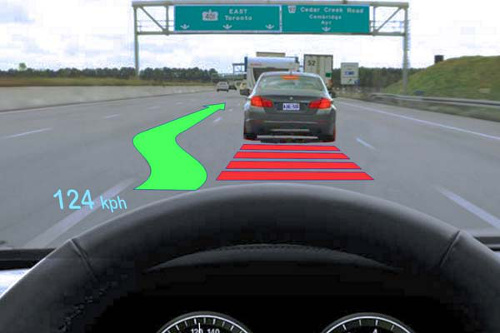 |
| July 21, 2015 | Volume 11 Issue 27 |
Designfax weekly eMagazine
Archives
Partners
Manufacturing Center
Product Spotlight
Modern Applications News
Metalworking Ideas For
Today's Job Shops
Tooling and Production
Strategies for large
metalworking plants
Study: Digital messages on windshields make driving less safe

Warnings and driving suggestions will appear occasionally with augmented-reality displays.
Augmented-reality head-up displays (AR-HUDs) that present digital images on windshields to alert drivers to everything from possible collisions to smartphone activity are meant to make driving safer. But University of Toronto researchers say they are the opposite: a threat to safety.
"Drivers need to divide their attention to deal with this added visual information," said Department of Psychology professor Ian Spence, who investigated what happens when two sources of information are present in the same visual field.
"Not only will drivers have to concentrate on what's happening on the road around them as they've always done, they'll also have to attend to whatever warning pops up on the windshield in front of them."
Spence and his students, Yuechuan Sun and Sijing Wu, designed two tests to measure the impact of this added visual information. Participants first completed a series of computer-based trials in which they reported a number of randomly arranged spots (between one and nine) displayed on a screen as quickly and accurately as possible when prompted.
On some trials, they were presented with a secondary stimulus in the form of a black-outlined square, and were asked to report whether they saw it or not. The spots and shape were displayed together and the shape appeared unpredictably in only some of the trials.
Accuracy was high when the square was absent, suggesting little attention was required to confirm that the square had not appeared. However, when the square appeared along with a small number of spots, it was missed about one in 15 times on average.
When the number of spots increased, the rate climbed to one in 10 instances, suggesting that if attention is increasingly occuped by the primary task, participants will have more difficulty attending to the secondary task stimulus. The accuracy of the number of spots reported also diminshed as the number of spots increased, suggesting that as a primary task becomes more demanding, both tasks compete with and interfere with each other.
In a real-life situation -- such as driving a vehicle -- even more is demanded of a driver. It is not enough to simply see something unexpected; one must identify what is seen and respond appropriately.
"It would be necessary to distinguish, for example, between warnings of a collision and a recommendation to make a turn," said Spence. "Otherwise, competing warnings may be more dangerous than no warning at all."
To test this, the researchers asked participants to identify the appearance of a random distinctive shape -- a triangle, square, or diamond -- among the spots. Again, the spots and shape were displayed together, and the shape appeared unpredictably -- much as an AR display would only appear when something is happening outside the vehicle.
In cases with larger numbers of spots, the shape was often misidentified or missed altogether and, as with the first experiment, estimating the number of spots was more difficult when the shape appeared.
"Observers made both judgements more slowly when the shape appeared among the spots by as much as 200 percent," said Spence. "The two visual tasks interfered with each other and impaired both reaction speed and accuracy.
"Missed warnings and slowed reaction times present real threats to safety," said Spence. "Furthermore, this rivalry for the driver's attention is most likely to occur when the driving environment is demanding."
The study, "The commingled division of visual attention" was published in June in PLOS ONE. The research was funded by a Discovery Grant to Spence from the Natural Sciences and Engineering Research Council of Canada.
Source: University of Toronto
Published July 2015
Rate this article
View our terms of use and privacy policy
